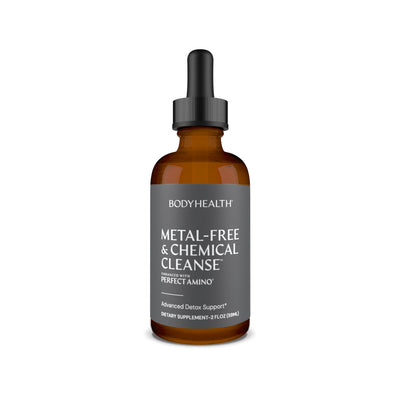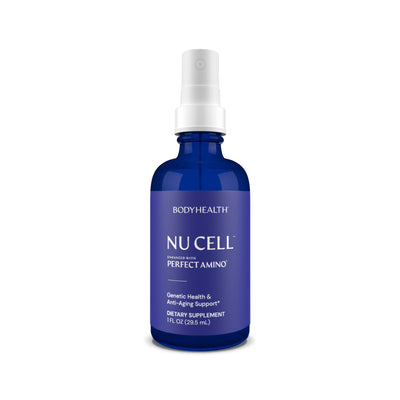What Are Free Radicals: Accelerated Aging, Skin, Cardiovascular & More
August 22, 2024 7 min read

There are certain things that accelerate aging, destroying our cells, far beyond anything else.
You’ve probably heard of them, but never gotten a real explanation for what they are or how they work.
They’re called free radicals.
These are incomplete molecules in our body, caused naturally or through toxins, harmful bacteria, radiation, and ingredients in many processed foods.
But while they do occur naturally on a lower level, when they’re too high, they cause destruction throughout our body.
They can affect our skin, creating dry or sagging skin over time, or lead to disruptions in our skin.
They affect our hormones and hormonal balance.
They lower our energy levels while raising immune activity.
They affect our cardiovascular system, injuring our blood vessels.
They can break down proteins in our cells, harm our DNA, and even cause mutations.
And they raise stress levels throughout our nervous system, making it harder to relax, recover from workouts or activity, or get good, deep sleep.
In short, they’re not good. And as they’re at an all time high with today’s environmental pollutants and chemicals in our foods, we need to take active steps to neutralize them to prevent damage in the body.
So let’s dive in.
FREE RADICALS: HOW THEY WORK
We’re going to go very deep here for a minute, then we’ll come back up.
You've heard of or know what an atom is.
Very basically, it contains a particle called a neutron at its center, and circling around it are other particles called electrons and protons.
Think of it as the solar system: the neutron is the sun, and the electrons and protons are planets orbiting around them. Not exact, but good enough for an example.
Except this solar system can only be seen by the best microscopes.
When atoms join together, they're called molecules. And, in your body (and everywhere else), they come together to make groups of molecules, like amino acids or fatty acids. And together these build up to make larger things like cells.
Okay. So a molecule is small. But it’s what your cells are made of. And it’s very exact. And very stable.
Now, when a cell dies, the molecules that made up that cell are broken apart… And some can be damaged. What that means is, on some, they can lose one of their electrons.
But they need that electron. It makes them stable. Now they’re off-kilter and they don’t like that.
So what do they do? Well, they go and steal an electron from another molecule, of course. Maybe one that’s still part of a cell.
But now that one is unstable. So it steals one from another molecule, which then steals one from another, etc, etc.
Okay. This causes trouble in a cell.
It can alter the cell’s membrane, making it less functional.
It can open “holes” in the cell so important things get out and harmful things get in.
It can prevent or impair cell-signaling, communication, such as with hormones, so messages can’t be delivered to or by the cell.
And it can lead to the cell’s death.
We don't like any of these things.
Luckily, other specific molecules made by our body, and that we get from plants and fruits, can take these free radicals and give them what they want — that missing electron. And they can do so without causing themselves to become free radicals.
These are called antioxidants. And for different types of free radicals, there are different types of antioxidants the body uses to neutralize them.
You’ve heard of many of them: Vitamins C, E & A, Zinc, Selenium and Copper, and Flavonoids and Polyphenols (antioxidants in fruits, vegetables, tea, cocoa, and red wine).
These are antioxidants.
(Now you know one reason vitamins are so important.)
Also, the Fullerene in our Metal-Free & Chemical Cleanse and the Astaxanthin in our Omega 3 Health are two of the most powerful antioxidants there are.
And our Reds has a very potent concentration of many different antioxidants to fight free radicals from every angle.
These help to protect the molecules holding healthy cells together from being harmed by free radicals.
Alright.
Now, if the natural death of a cell was the only thing creating free radicals, we’d be fine. Our body, using antioxidants that it makes and that it gets from the foods we eat, could easily neutralize any free radicals.
We even have natural free radical formation during metabolism — the creation of energy inside the cell.
And our immune system produces free radicals intentionally to attack harmful bacteria and other pathogens.
So our body is set up to handle these when they’re at a normal level.
Unfortunately, these aren’t the only way we get free radicals.
And the number of ways we get them has been increasing every year for decades. Far beyond our body’s ability to neutralize. And they’re causing injury and death to cells faster and faster each year.
People in their 30’s now have more free radicals causing harm in their bodies than people in their 60’s did decades ago.
As we know that we only have a certain number of stem cells, and they only have a certain number of times they can divide to make replacement cells until they can no longer divide, knowing what’s harming our cells and speeding up the use of our stem cells becomes quite important to prevent accelerated aging.
HOW MANY FREE RADICALS DO WE HAVE
The number of ways free radicals occur in our body today is actually astonishing. And what they do in large numbers isn’t good.
As proteins are made of molecules, free radicals can disrupt proteins inside our bodies, whether in cells or in our hormones or enzymes, impairing their ability to do their jobs.
They can harm fatty acid structures our body needs, like the membranes around each of our cells.
They can even harm our DNA, causing changes to the DNA that lead to the improper formation of cells and even to mutations in cells that cause us a lot of trouble down the road.
But also, this is DNA we’re talking about. Something we pass down. So we’re not just talking about mutations in our own cells now, but in our children and grandchildren’s cells.
Yes. Extreme free radical damage can have multi-generational effects.
So where are they coming from?
We covered natural sources, now let’s cover the unnatural:
Environmental factors: Environmental pollutants, such as cigarette smoke, air pollution, and radiation, can contribute to free radical formation by injuring cells and releasing free radicals.
And we already know these toxins are at very high levels in our environment today (fifty times what they were 70 years ago).
UV radiation: Sun exposure, specifically ultraviolet (UV) radiation, can generate free radicals in skin cells.
Medications and chemicals: Certain medications and chemicals can generate free radicals as a result of their actions and interactions in our body.
And these medications ad chemicals reach us even if we’re not taking them. You see, if someone takes a specific medication, it later on leaves there body and enters the city’s water supplies. And the filtration done to that water doesn’t remove these things in the slightest. So it comes back through our kitchen sink.
Processed Sugars and Processed Foods with high Omega 6 levels: these raise inflammatory markers in our bodies, which then cause free radical formation to the degree we consume them. High markers means high levels of free radicals.
Now, any one of these would be a lot for the body, especially in the volume they exist in today.
But all together they significantly affect us, and very much do accelerate our rate of biological aging.
Free radicals even accelerate telomere shortening, those little tails that shorten each time a stem cell divides. This leads to these telomeres not lasting as long as they should, even beyond just being used heavily.
Okay. So what can we do?
FIGHTING FREE RADICAL DAMAGE
First, we need to limit our exposure to environmental toxins as much as we can. They harm our cells, our DNA and even our hormones and hormonal balances.
A good reverse-osmosis water filter attached to your kitchen sink removes more toxins, chemicals, bacteria and medications coming through your water than anything else.
We need to eat natural foods, not processed foods and sugars, and we need to make sure they’re organic, or at least part of the Clean 15 and not the Dirty Dozen. (Look those up for the most up to date lists.)
We need to make sure we’re taking our Omega 3 fatty acids to balance our Omega 3/6 ratios.
We need to make sure we’re taking our vitamins and other natural antioxidant sources.
But, the way our foods are grown and processed these days, many of these vitamins and antioxidants are either less abundant in fruits and vegetables, or entirely stripped out during the processing of them.
Our Multi Complete covers every vitamin our body needs in bio-significant amounts and in forms our bodies can actually absorb and utilize.
These free radicals also act to raise homocysteine levels, which significantly impacts the health and function of our heart and cardiovascular system.
CardioVascular specifically addresses this, helping to reduce homocysteine levels, address methylation, increase blood flow, and much more.
It addresses every aspect of heart health and is very effective.
Our Reds contain one of the most diverse formulations of antioxidants to fight different types of free radicals in our body. It’s one of our most potent weapons against these.
We also need to rid our bodies of the toxins that are already in them creating more free radicals. Metal-Free & Chemical Cleanse is not only one of the most effective detoxifiers, it also contains one of the most powerful antioxidants there are: fullerenes.
We need to stay hydrated: Proper hydration supports overall cellular function and aids in the elimination of toxins. PerfectAmino Electrolytes helps maintain the body’s proper hydration levels.
And we need to get regular exercise. Exercise enhances the body's natural antioxidant defense mechanisms.
And, of course, we need to give our body the amino acids it needs to heal from cellular damage, as in PerfectAmino.
In today’s world, fighting free radical damage is one of the most important things we can do for overall health and well-being.
I hope this helps.
REFERENCES:
- Pham-Huy LA, He H, Pham-Huy C. Free radicals, antioxidants in disease and health. Int J Biomed Sci. 2008;4(2):89-96.
- Rahman K. Studies on free radicals, antioxidants, and co-factors. Clin Interv Aging. 2007;2(2):219-236.
- Pérez-Torres I, Guarner-Lans V. The Role of Antioxidants in the Aging Process. Antioxidants (Basel). 2020;9(8):751.
- Mayo Clinic. Antioxidants: Beyond the Hype
- Harvard T.H. Chan School of Public Health. Antioxidants: Beyond the Hype
- Linus Pauling Institute. Micronutrient Information Center: Antioxidants
- American Heart Association. Good vs. Bad Cholesterol
- American Psychological Association. Stress Effects on the Body
- Centers for Disease Control and Prevention. Tips for Quitting Smoking
Articles by Health Topic
Your Path To Better Health Starts Here!
From in-depth articles on nutritional benefits to updates on new product launches, stay informed and inspired on your journey to optimal health.
*These statements have not been evaluated by the Food and Drug Administration. These products are not intended to diagnose, treat, cure, or prevent any disease.










